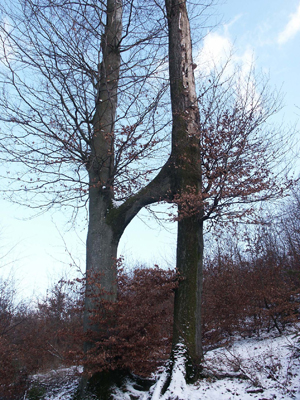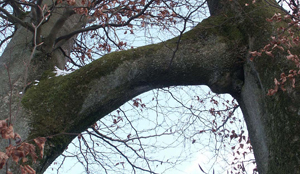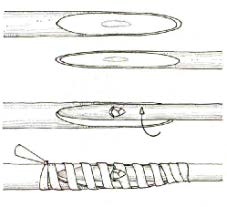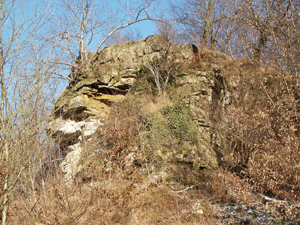 Among the trees in the Grünewald you can easily notice the “conjoined beeches”, not far from here. This strange shape is not the result of a natural phenomenon, but probably of a human intervention: the lateral branches had been put together very early.
Among the trees in the Grünewald you can easily notice the “conjoined beeches”, not far from here. This strange shape is not the result of a natural phenomenon, but probably of a human intervention: the lateral branches had been put together very early.
Probably two of these branches with the same width had been bevelled and superposed in order to make them grow together.

“Conjoined beeches” No freak of nature !
This union was easily possible, as the young beech branches were strong enough to regenerate and scar over the cut surface. While growing; the central part of a tree is always covered by an outer layer of cambium, the so-called growing zone. This zone produces new tissue in two directions: wood (xylem) inwardly and bast (phloem) outwards. The bark is formed from old bast. The laceration of the lateral branches could scar with the help of a special tissue called “callus”, made by the presence of cambium. Later on the cut wound had been dressed with the help of raffia or rubber ribbons or a thick wax layer had been spread. And with the time passing by two single beeches became one double structured beech.
 The dressing and soldering of two branches of different species is a common graft procedure in horticulture.
The dressing and soldering of two branches of different species is a common graft procedure in horticulture.
“Hunnefiels”
 Not far from the Roman “Kiem” there lays a huge sandstone rock, called “Hunnefiels”. It is supposed that its alcoves were inhabited in prehistoric times. The name “Hunnefiels” still valid today, comes from the times when the Huns did occupy the region.
Not far from the Roman “Kiem” there lays a huge sandstone rock, called “Hunnefiels”. It is supposed that its alcoves were inhabited in prehistoric times. The name “Hunnefiels” still valid today, comes from the times when the Huns did occupy the region.
